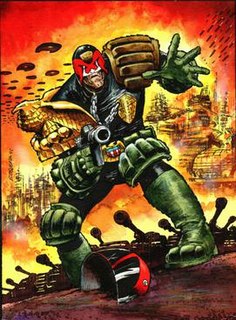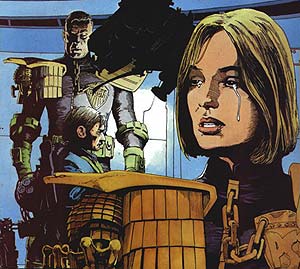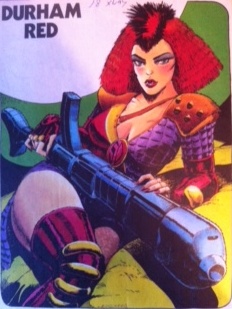
Judge Dredd is a comic book franchise based on the longest-running comic strip in 2000 AD (1977), a British weekly anthology comic.

2000 AD is a weekly British science fiction-oriented comic magazine. As a comics anthology it serialises stories in each issue and was first published by IPC Magazines in 1977, the first issue dated 26 February. IPC then shifted the title to its Fleetway comics subsidiary, which was sold to Robert Maxwell in 1987 and then to Egmont UK in 1991. Fleetway continued to produce the title until 2000, when it was bought by Rebellion Developments.

Judge Cassandra Anderson is a fictional law enforcer and psychic appearing in the British science fiction comics 2000 AD and the Judge Dredd Megazine. Created by writer John Wagner and artist Brian Bolland, Anderson made her debut as a supporting character in the Judge Dredd story "Judge Death". The character's popularity with readers led to her starring in her own series, Anderson: Psi-Division, which has been written almost exclusively by Alan Grant, often working with artist Arthur Ranson until 2005; Boo Cook drew a majority of the stories until 2012, since which a number of different artists have worked on the strip. In 2012 the character appeared in the film Dredd, played by Olivia Thirlby.

Mega-City One is a huge fictional post-nuclear megalopolis-size megacity city-state covering much of what is now the Eastern United States and some of Canada in the Judge Dredd comic book series and its spinoff series. The exact geography of the city depends on which writer and artist has done which story, but from its first appearance it has been associated with New York City's urban sprawl; originally it was presented as a future New York, which was retconned as the centre of a "Mega-City One" in the very next story.

Carlos Sanchez Ezquerra was a Spanish comics artist who worked mainly in British comics. He is best known as the co-creator of Judge Dredd.

Judge is a title held by several significant characters in Judge Dredd and other series which appear in the British comics 2000 AD and Judge Dredd Megazine. In the fictional future history of the series, the role of "Judge" combines those of judge, jury and police officer, thus avoiding long legal wrangles by allowing for criminals to be tried and sentenced on the spot. Since they overthrew the U.S. Constitution in 2070, Judges have also held supreme political power in Mega-City One. Collectively they are known as the Justice Department.

Durham Red is a British comics character, originally created in 1987 as a female sidekick and lover for Johnny Alpha in the long-running comic book series Strontium Dog in 2000 AD. She is a bounty hunter with a mutation that gives her a vampiric lust for blood.
"Necropolis" is a 26-part story featuring British comics science fiction character Judge Dredd. Written by John Wagner and painted by Carlos Ezquerra, it was published in 1990 in 2000 AD progs 674–699. The story was the subject of extensive foreshadowing in the comic, beginning with The Dead Man, followed by "Tale of the Dead Man", and finally three stories collectively known as "Countdown to Necropolis". It pulled together various story threads going back four years (see also Democracy ). "Necropolis" was also followed by a number of epilogues and other follow-up stories, and had repercussions within the Judge Dredd strip which lasted for years.
Peter Doherty is a British comic book artist and colourist.

2000 AD crossovers are crossover stories appearing in British comic 2000 AD, its sister title the Judge Dredd Megazine, and other related output, such as novels, audio plays, films and role-playing games.
"Judgement Day" is a story of British science fiction character Judge Dredd. It was first published with alternating episodes in both 2000 AD and the Judge Dredd Megazine in 1992. It was the first crossover between the two publications; three more have since followed. It was also a crossover with another 2000 AD series, Strontium Dog, as it featured the second occasion on which Judge Dredd confronted Johnny Alpha. It was written by Garth Ennis and illustrated by Carlos Ezquerra, Peter Doherty, Dean Ormston and Chris Halls.
Democracy in the fictional future city of Mega-City One has been a significant recurring theme in the Judge Dredd comic strip in 2000 AD. In particular, a number of stories published since 1986 have addressed the issue of the Judges' dictatorial system of government, and efforts by the citizens to re-establish democracy. Besides being a notable story arc in itself, the "Democracy" stories also had wider repercussions which led directly to the events depicted in the story "Necropolis".
Colin MacNeil is a British comics artist, best known for his work on 2000 AD and in particular on Judge Dredd and other stories within his world like Shimura and Devlin Waugh.
"The Pit" is a Judge Dredd story which appeared in British comic 2000 AD in 1995–1996. With 30 episodes, it had the greatest number of episodes of any single Judge Dredd story until "The Doomsday Scenario" in 1999. It introduced the supporting characters of Galen DeMarco, Judge Guthrie and Judge Buell. It tells of Judge Dredd's temporary assignment as the sector chief of Sector 301.
The Doomsday Scenario is the collective name of a series of Judge Dredd comic stories published in 2000 AD and the Judge Dredd Megazine in 1999. Written by John Wagner, it was the third such crossover story between those two publications, but was the first in which it was possible to read a complete and coherent tale by reading only those episodes which appeared in one comic or the other without having to buy both magazines. It was reprinted as two trade paperbacks, each collecting the episodes from one comic. When first published it was the longest Judge Dredd story arc ever told, at a total of 32 episodes and 279 pages, as well as several prequels and epilogues. The story tells of the Second Robot War in the year 2121, but its epilogues wrapped up two story arcs that had been developing for several years: former judge Galen DeMarco's unrequited love for Judge Dredd, and Dredd's bitter rivalry with Judge Edgar. The story is also notable for leading to the promotion of Judge Hershey, Dredd's sidekick and one of the strip's longest-running supporting characters, to the office of chief judge.

This is a list of works by Scottish author Alan Grant.
"Tour of Duty" is a Judge Dredd story published in British comic 2000 AD (2009–2010). It lasted for 46 episodes, 39 of which were written by John Wagner. It has the second greatest number of episodes and pages (285) of any Judge Dredd story. It is part of a longer storyline about mutants.

Silencer is an original novel written by David Bishop and based on the long-running British science fiction comic strip Judge Dredd. It is Bishop's third Judge Dredd novel. At the time of publication (1994) Bishop was editor of the Judge Dredd Megazine.

Judge Joseph Dredd is a fictional character created by writer John Wagner and artist Carlos Ezquerra. He first appeared in the second issue of 2000 AD (1977), which is a British weekly anthology comic. He is the magazine's longest-running character. He also appears in a number of film and video game adaptations.












